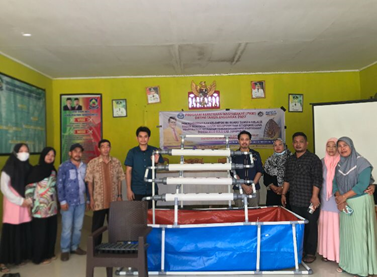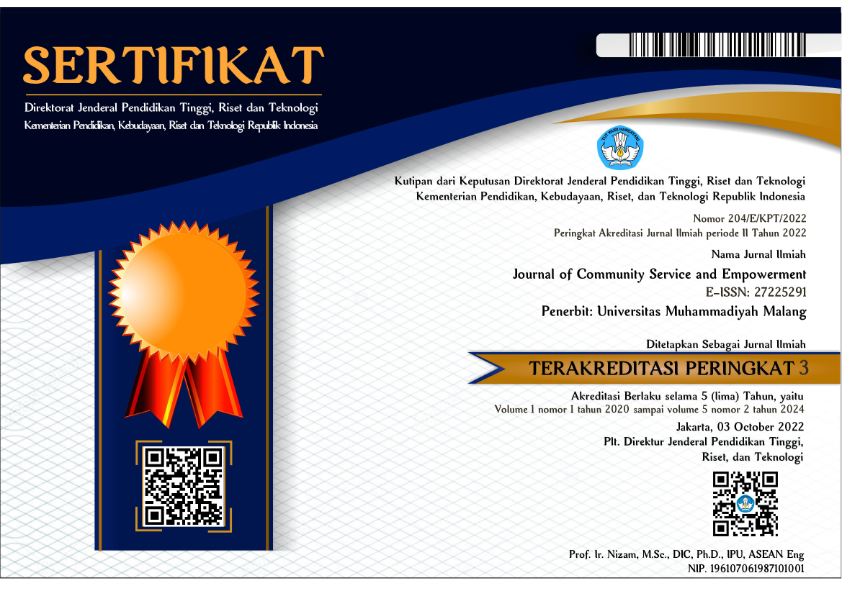Increasing community food security through aquaponic and aeroponic cultivation
DOI:
https://doi.org/10.22219/jcse.v3i3.22806Keywords:
Community partnership program, Aeroponics, Aquaponics, Food securityAbstract
The topographical conditions in Bulo-Bulo Village, Jeneponto Regency, South Sulawesi, tend to be bumpy and rocky, which is the main problem in farming. Locals exclusively use growing methods because there is little public awareness about cultivation technologies. The community employs a number of different fish farming systems. Additionally, the cost of fish feed has a tendency to change, making it harder for people to satisfy their needs for the primary protein source. The community can be counseled on land use by using aquaponic and aeroponic systems as a possible solution to the issue. Regardless of climatic conditions or current land characteristics, aquaponic technology is recognized as a substitute for integrated farming systems. By providing counseling, instruction, and hands-on support to the residents of Bulo-Bulo Village, the strategy is put into action. The results of this action take the shape of autonomous aquaponic and aeroponic installations that grow food crops and fish in the same space to reduce production costs and increase earnings. Every family in the community is intended to be able to benefit from this activity and use the farming technology in order to reinforce and encourage long-term improvements in the nation of Indonesia's food security.
Downloads
References
Anandhiya, A., Arifin, A., & Istiqomah, I. (2021). Pengaruh Ketahanan Pangan terhadap Rata-Rata Pengeluaran Masyarakat di Jawa Tengah. Jurnal Ilmiah Universitas Batanghari Jambi, 21(1), 96. https://doi.org/10.33087/jiubj.v21i1.1258
Aripriharta, A., Firmansah, A., Faiz, M. R., Satrio, Y. D., Sunaryono, S., & Fitriyandi, M. R. (2022). Revitalisasi tani kabupaten sebagai pilot project kebangkitan ekonomi masyarakat Sengkaling. IJCOSIN: Indonesian Journal of Community Service and Innovation, 2(1), 47–55. https://doi.org/10.20895/ijcosin.v2i1.388
Dirgantara, W. A. (2022). Monitoring Aquaponik dengan Android untuk Meningkatkan Minat Masyarakat dalam Bercocok Tanam di Kecamatan Porong. Abdimas: Jurnal Pengabdian Masyarakat Universitas Merdeka Malang, 6(1), 133-141.
Djamali, R. A. (2022). Penyusunan Rencana Induk Pengembangan Kawasan Rumah Pangan Lestari (KRPL) di Kampung SDGS Bangsalsari Kabupaten Jember. J-ABDI: Jurnal Pengabdian kepada Masyarakat, 1(9), 2493-2502
Dwi P. H., Rahman Singkam, A., Fauzi, H., & Izzudin Al Qosam, M. (2021). Hubungan Antara Keanekaragaman Tanaman Pekarangan Dengan Pola Sosial Budaya Masyarakat Setempat. Biotropika: Journal of Tropical Biology, 9(2), 136– 143. https://doi.org/10.21776/ub.biotropika.2021.009.02.06
Farikhotin, S. N., & Sary, S. N., (2022). Food Bank sebagai Bentuk Kepedulian Generasi Z Peduli Ketahanan Pangan dengan Integrasi Sekolah dan Masyarakat dari Pemanfaatan Food Waste. Prosiding Pekan Ilmiah …, 745–751. http://ejournal.unmas.ac.id/index.php/pilar/article/view/4520
Fuadina, L. N., Rustiadi, E., & Pravitasari, A. E. (2021). Analisis Faktor-Faktor yang Mempengaruhi Urban Sprawl di Kawasan Cekungan Bandung. Tataloka, 23(1), 105–114. https://doi.org/10.14710/tataloka.23.1.105-114
Hakim, M. A. (2020). Urban farming metode teknologi inovasi batu pada pertanian perkotaan. Urban Farming Solusi Pertanian Perkotaan, 1–23.
Handayani, L. (2018). Pemanfaatan lahan sempit dengan sistem budidaya aquaponik. In prosiding seminar nasional hasil pengabdian, 1 (1), 118-126. https://doi.org/10.25008/altifani.v1i4.181
Irawan, M. S. (2021). Kontrol pH Sistem Aeroponik Pada Tanaman Strawberry Menggunakan Metode Fuzzy Logic. .
CYCLOTRON, 4(1), 51-54. http://dx.doi.org/10.30651/cl.v4i1.5898
Khomah, I., & Fajarningsih, R. U. (2016). Potensi dan Prospek Pemanfaatan Lahan Pekarangan terhadap Pendapatan Rumah Tangga. Procceding Seminar Nasional Peningkatan Kapabilitas UMKM Dalam Mewujudkan UMKM Naik Kelas Pemanfaatan, 155–161.
Khan, M. M., Akram, M. T., Janke, R., Qadri, R. W. K., Al-Sadi, A. M., & Farooque, A. A. (2020). Urban horticulture for food secure cities through and beyond COVID-19. Sustainability, 12(22), 9592.
Lakhiar, I. A., Gao, J., Syed, T. N., Chandio, F. A., Tunio, M. H., Ahmad, F., & Solangi, K. A. (2020). Overview of the aeroponic agriculture–An emerging technology for global food security. International Journal of Agricultural and Biological Engineering, 13(1), 1-10. http://www.ijabe.org/index.php/ijabe/article/view/5156/pdf
Nawir, A., Syamsuddin, & Jusniaty. (2022). Penerapan Program Sustainable Development Goals (Sdgs) Desa Polewali dalam Mengurangi Kemiskinan. DEMOKRASI: Jurnal Ilmu Pemerintahan UM Malang, 2(1), 1–18.
Putra, Y. A., Siregar, G., & Utami, S. (2019). Peningkatan pendapatan masyarakat melalui pemanfaatan pekarangan
dengan tekhnik budidaya hidroponik. Proseding Seminar Nasional Kewirausahaan, 1(1), 122–127. http://jurnal.umsu.ac.id/index.php/snk/article/view/3589
Rizal, A., Dhahiyat, Y., Zahidah, Andriani, Y., Handaka, A. A., & Sahidin, A. (2018). The economic and social benefits of an aquaponic system for the integrated production of fish and water plants. IOP Conference Series: Earth and Environmental Science, 137(1–8). https://doi.org/10.1088/1755-1315/137/1/012098
Rokhmah, N. A. (2014). Vertiminaponik, mini akuaponik untuk lahan sempit di perkotaan. Buletin Pertanian Perkotaan.
(2), 14-22. http://jakarta.litbang.pertanian.go.id/ind/artikel%20bptp/buletin%20vertiminaponik%20vol4%20 Saputra, M. A. (2019). Penerapan Metode Profile Matching dalam Penentuan Jenis Tanaman. Jurnal Sistem dan
Informatika (JSI), 13(2), 46-51. https://www.jsi.stikom-bali.ac.id/index.php/jsi/article/view/198
Sari, A. S. (2022). Pemanfaatan Lahan Sempit Untuk Budidaya Aquaponik di Desa Sumberbendo. . KARYA UNGGUL- Jurnal Pengabdian Kepada Masyarakat, 1(2 ), 256-263. https://ojs.atds.ac.id/index
Sastro, Y. (2016). Teknologi Akuaponik Mendukung Pengembangan Urban Farming.
Setiawan, A. N., & Wijayanti, S. N. (2019). Desa Mandiri Pangan Berbasis Pekarangan Di Donokerto, Turi, Sleman, Diy.
Adimas : Jurnal Pengabdian Kepada Masyarakat, 3(2), 16. https://doi.org/10.24269/adi.v3i2.1828
Setiawan, G. A. (2021). Smart Farming Tanaman Selada (Romaine) Dengan Sistem Aeroponik Berbasis IOT. . Informatics, Electrical and Electronics Engineering (Infotron), 1(1), 37-49. http://dx.doi.org/10.33474/infotron.v1i1.11355
Shooliha, M. F. (2022). Pemberdayaan Kewirausahaan Bercocok Tanam untuk Meningkatkan Penghasilan Dd Masa Pandemi Covid-19 (Pada Kelompok Wanita Tani Puri Pamulang). Jurnal Pengabdian Kepada Masyarakat (PKM): Kreasi Mahasiswa Manajemen, 2(1), 72-83. . http://openjournal.unpam.ac.id/index.php/KMM/article/viewFile/20954/10482
Slameto, S. F. (2022). Penerapan Teknologi Aeroponik untuk Produksi Benih Kentang di Desa Ngadisari Kabupaten Probolinggo. Dharmakarya, . 11(1), 51-54. https://doi.org/10.24198/dharmakarya.v11i1.36136
Ternando, H. (2021). Faktor - Faktor yang Mempengaruhi Kepatuhan Wajib Pajak Bumi dan Bangunan di Kecamatan Tarowang Kabupaten Jeneponto. Universitas Muhammadiyah Makassar.
Widianingsih, W., Suryantini, A., & Irham, I. (2015). Kontribusi Sektor Pertanian Pada Pertumbuhan Ekonomi Di Provinsi Jawa Barat. Agro Ekonomi, 26(2), 206–218. https://doi.org/10.22146/agroekonomi.17272
Yani, A. Y. (2020). Pemanfaatan Lahan Terbatas Dalam Menunjang Ketahanan Pangan Di Era Covid-19. Jurnal Imiah Management Agribisnis (Jimanggis), 1(2), 125-136. https://doi.org/10.48093/jimanggis.v1i2.47

Downloads
Published
How to Cite
Issue
Section
License
Copyright (c) 2022 Arsad Bahri, Jabal Rahmat Ashar, Zakia Asrifah Ramly, Andi Wahyudi Fajriansyah Al-Ghifari, Nur Aisyah Ainun, Yusuf Arisandi, Wahyu Hidayat

This work is licensed under a Creative Commons Attribution-ShareAlike 4.0 International License.












